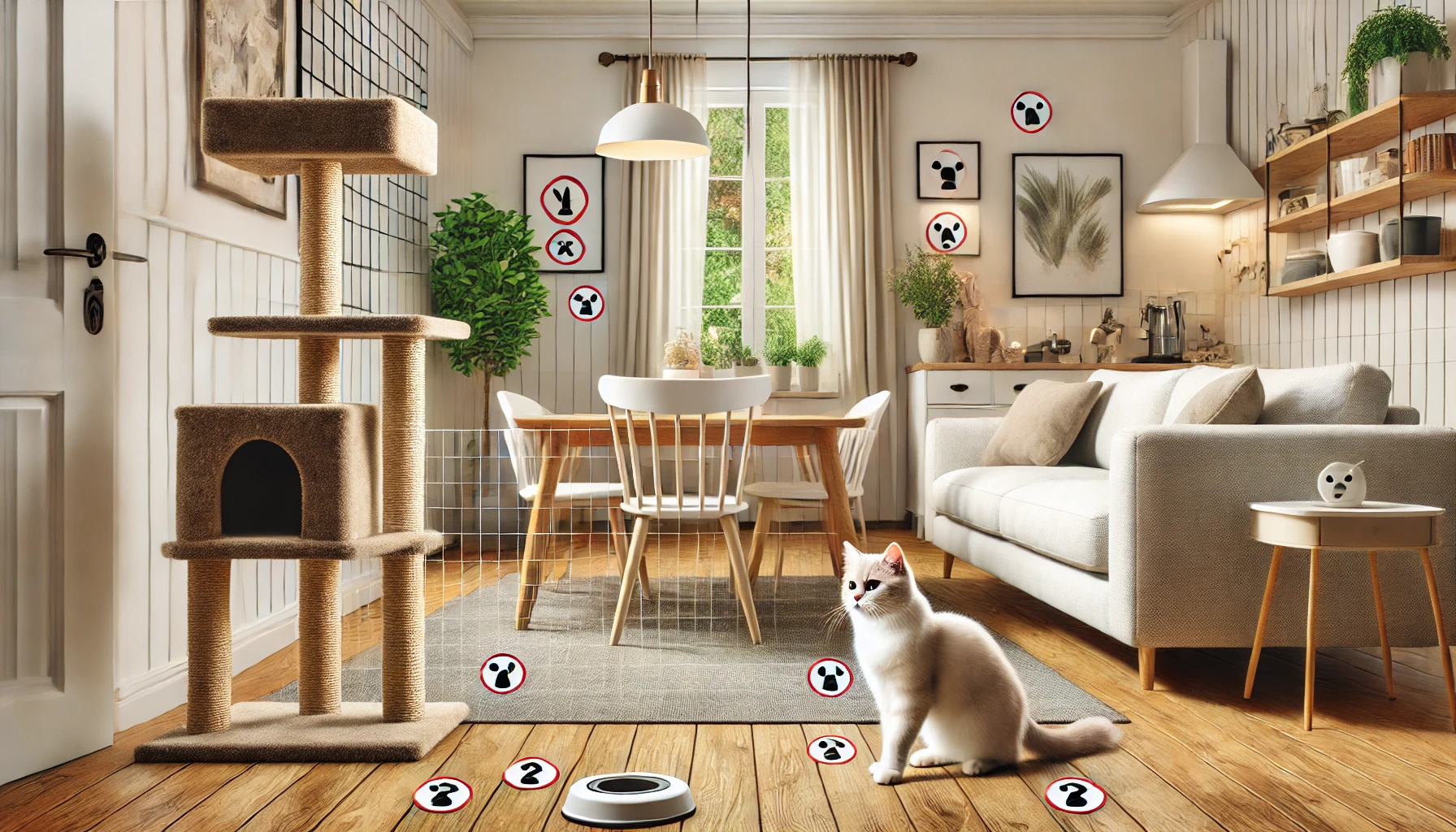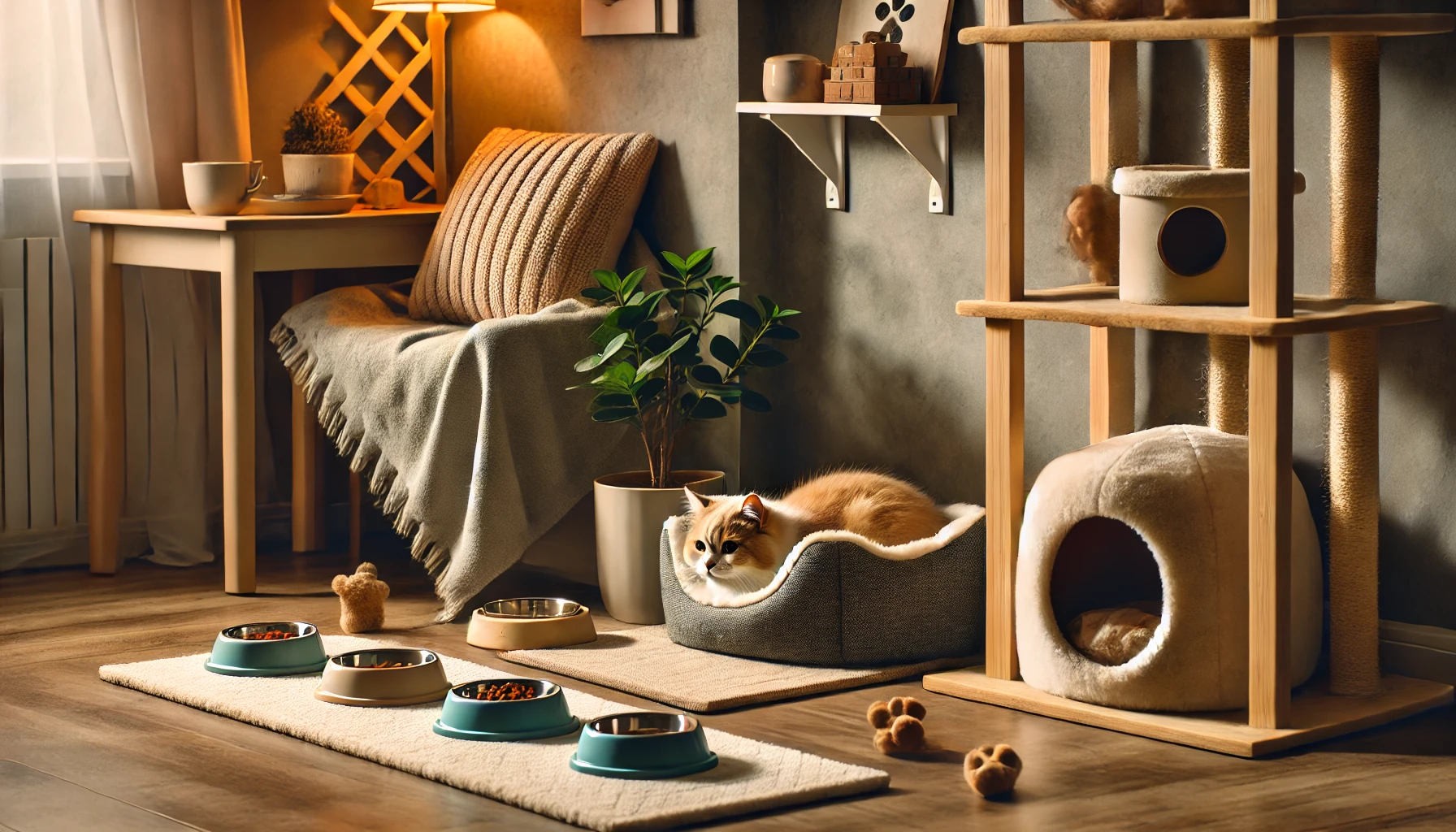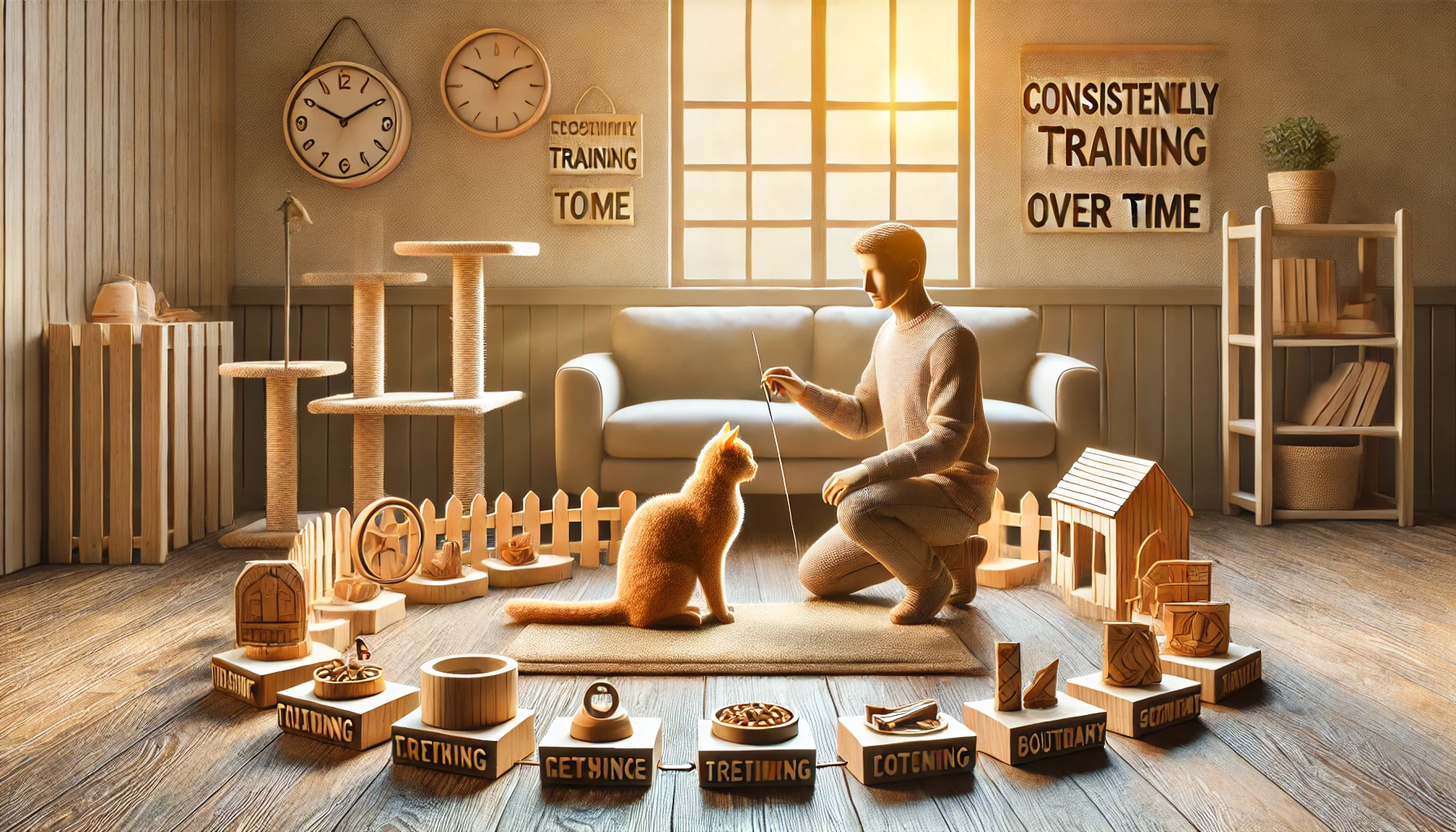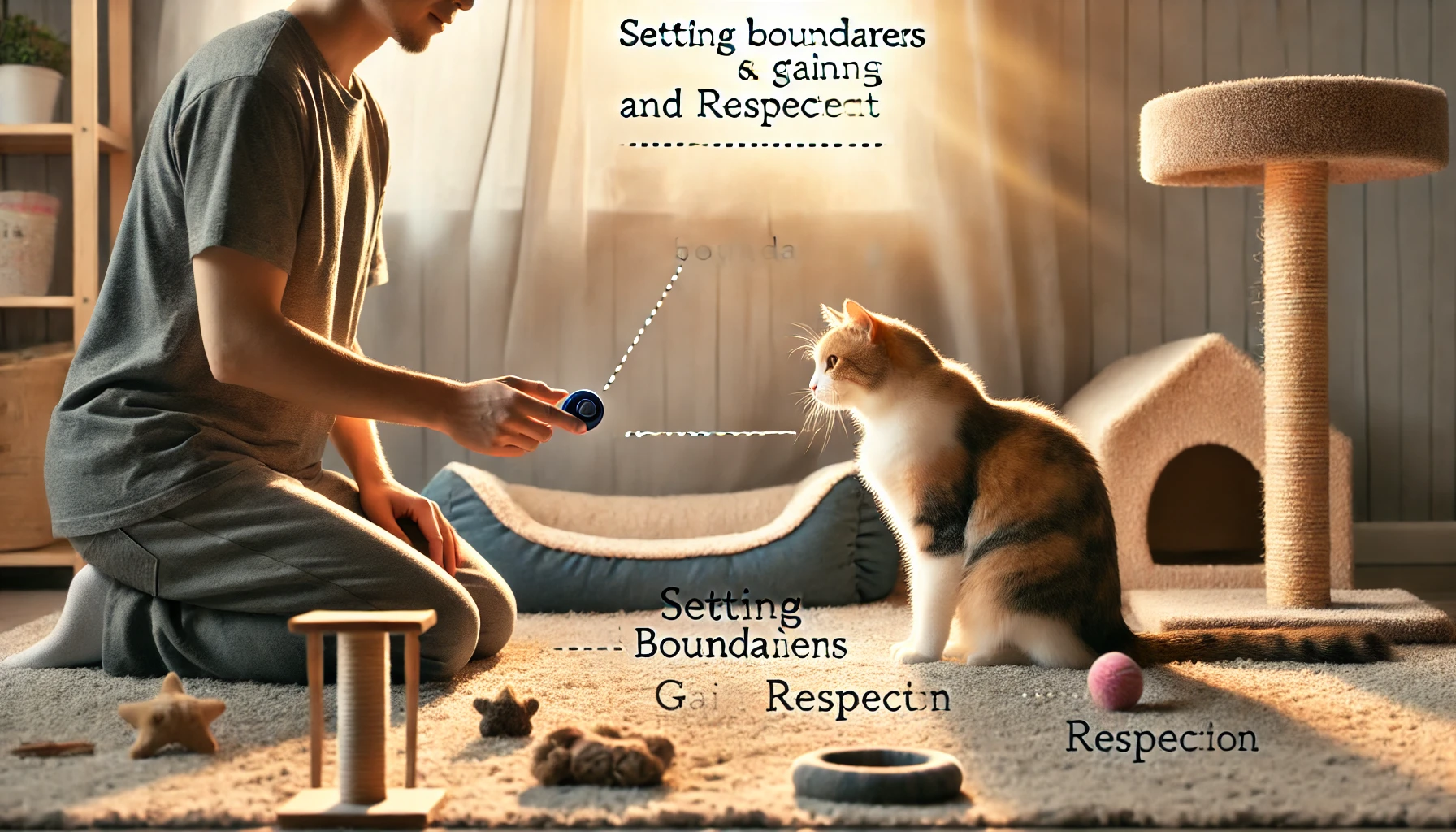Teaching Cats to Respect Boundaries at Home

As a cat owner, you want your felines to be cherished, but at times, they get demanding—especially in regard to respecting some of the boundaries in the house.
Cats are naturally curious animals, and their independent nature often turns them into explorers of every corner of your home, whether it is forbidden or allowed.
Setting boundaries will help with keeping your home in order, ensuring your cat’s well-being, and protecting your furniture or personal space.
But how do you teach a cat—notorious for its aloofness and sometimes outright stubbornness—to respect the limits you’ve set?
This article will guide you through the ways of teaching your cat how to understand these boundaries and how to go about doing it in a sensitive, positive manner.
Table of Contents
Why Teaching Cats to Respect Boundaries is Important
Training a cat to respect boundaries goes beyond just keeping them off the kitchen counter or stopping them from scratching your sofa.
Boundaries are essential for establishing a sense of structure and security for your cat, which will ultimately make them feel more at ease in their environment.
Cats thrive in spaces where they know what they can and cannot do.
Without boundaries, cats can become stressed, anxious, or even destructive.
Setting limits also plays an important role in balancing your needs as a pet owner with the instinctive behavior of your cat.
This may involve keeping areas of the house off-limits or ensuring that your cat does not disrupt your daily activities.
Respecting these boundaries is key to creating a harmonious coexistence between you and your cat.

Understanding Cat Behavior and Limits
Before you begin training your cat, it’s important to understand why cats behave the way they do.
Unlike dogs, cats aren’t pack animals and don’t naturally follow a leader.
This means their concept of ‘rules’ is different.
Cats are territorial creatures—they survey every inch of their home to feel secure.
It’s only natural for them to jump, scratch, and mark their territory, which might include your favorite couch or countertop.
While these behaviors are natural, it doesn’t mean they can’t be redirected.
A cat’s ability to adapt to boundaries depends largely on how consistent and patient you are as an owner.
Respecting boundaries starts with providing your cat with safe and acceptable places to express their natural behaviors.
Without alternatives, like scratching posts or designated cat areas, your cat might ignore the boundaries you try to set.

How Setting Boundaries Can Improve Your Cat’s Lifestyle
The more a cat understands its limits and boundaries, the safer and more comfortable it will feel in its environment.
Cats thrive in structured environments, which prevent the confusion that mixed signals can create.
For instance, if you provide a designated space for them to sleep, eat, and play, they will naturally gravitate towards those areas.
Boundaries provide your cat with predictability, which reduces stress and prevents problematic behaviors such as excessive scratching, aggression, or anxiety.
- Clear boundaries reduce anxiety and stress in your cat.
- Cats with defined boundaries feel more secure and are less likely to be destructive.
- Setting boundaries encourages better communication between you and your cat.

Boundaries and a Peaceful Home
Boundaries are not only about keeping your cat in check but also about creating a peaceful environment in your home.
By showing your cat what they can and cannot do, you protect your belongings while making your home a comfortable and stress-free space for both you and your cat.
When your cat understands and respects the boundaries you’ve set, you can enjoy their company without constantly worrying about damaged furniture or scattered belongings.
Establishing boundaries is one of the most important steps to creating a happy home, not just for you but for your feline friend too.
Teaching boundaries is essential for both cat well-being and harmonious living at home.

Setting Boundaries around Various House Areas
Setting boundaries for your cat involves much more than just keeping them out of particular rooms in the house.
It’s about creating clear-cut zones where your cat can find comfort and safety, while also ensuring your home remains protected.
Not every household is the same, nor are the areas in which one may want to set boundaries with their feline friend.
It’s important to acknowledge these areas and implement positive reinforcement so that your cat understands the boundaries clearly.
This way, they will be able to identify no-go zones and areas designed for rest and comfort.

Establishing Safe Zones for Your Cat
Cats need a place of their own, a spot where they can feel secure and relaxed.
These safe zones should be places your cat may retreat to whenever they start feeling nervous or overwhelmed.
Consider setting up a quiet corner with a comfortable bed or cat tree where they can climb and observe their surroundings.
This is especially necessary in multi-cat households to ensure each cat has its own space, preventing territorial disputes.
- A quiet room with minimal foot traffic
- A cozy nook with a cat tree or scratching post
- A window perch to allow your cat to observe the outside world
- Covered spots, like cat caves or beds, where they can retreat for privacy
These areas not only provide security but also create a natural boundary that separates your cat’s space from the rest of the home.

Keeping Cats Off Furniture and Counters
One of the most common boundary issues cat owners deal with is keeping cats off furniture and kitchen counters.
Cats naturally love to climb and jump, which makes it challenging to keep them off high-lying spaces.
However, it is possible to teach your cat to avoid certain surfaces by offering alternatives and using deterrents.
- Offer vertical spaces like cat trees or shelves where they can safely climb and jump.
- Use double-sided tape or motion-activated deterrents on furniture or countertops to make these surfaces unappealing.
- Place your cat’s favorite toys or treats in approved areas to encourage them to stay off forbidden surfaces.
With consistency, your cat will learn that certain parts of the house are off-limits, while others are perfect for their curious instincts.

Setting Limits around Feeding and Sleeping Spaces
Establishing boundaries around your cat’s feeding and sleeping areas is just as important as setting limits on where they can explore.
Cats are creatures of routine, and they thrive in environments with a clear schedule.
By designating specific areas for eating and sleeping, you help your cat feel more secure and reduce any anxiety related to mealtimes or rest.
For feeding areas, choose a quiet spot in your home away from high-traffic zones, and avoid placing their food near litter boxes.
Sleeping areas should be located in calm, cozy parts of the house where your cat can relax undisturbed.
Well-defined boundaries for feeding and sleeping areas create a sense of order in your cat’s daily life, making it easier for them to respect other limits you set throughout the house.
Establishing zones and safe spaces for your cat will ensure they feel comfortable while protecting your home.

Setting Boundaries Effectively Using Training Techniques
Training your cat to understand or respect boundaries involves patience, consistency, and a good understanding of feline behavior.
While cats are much more independent than other pets, setting boundaries is something they can learn and adjust to when communicated clearly.
You can teach your cat respect for the limits you have set using positive reinforcement, patience, and proper techniques.
Let’s explore some of the best training techniques that will help your cat understand their boundaries while maintaining their well-being and independence.

Positive Reinforcement in Teaching Respect for Boundaries
One of the best ways to train your cat is through the use of positive reinforcement.
Positive reinforcement rewards your pet for good behavior, rather than punishing them, which can lead to stress and fear.
The concept is simple: every time your cat respects a boundary, they receive a treat, praise, or affection.
Over time, respecting boundaries will become associated with positive outcomes.
- Give your cat a treat or toy each time they stay in their designated area.
- Reward your cat by praising or petting them immediately when they avoid counters, furniture, or other restricted areas.
- Consistency is key—ensure rewards are given promptly after the desired behavior to reinforce the connection.
This helps your cat view boundaries as a positive aspect of their environment, rather than a restrictive one.

Clicker Training for Boundary Training
One of the most popular and effective methods for setting boundaries with cats is clicker training.
A clicker is a small device that makes a clicking sound when pressed.
The click sound, combined with positive reinforcement, signals to your cat that they’ve done something right and a reward is coming.
This method can be highly effective for reinforcing boundary rules.
- First, get your cat accustomed to the clicker. Press the clicker and immediately give them a treat to create the association.
- When your cat respects a boundary (e.g., avoiding a restricted area), click and reward.
- Consistently repeat this process so your cat connects the click with good behavior and a reward.
Clicker training offers precise timing, which helps your cat quickly learn what behaviors are acceptable and which are not.

Handling Resistance: How to Handle a Cat When They Ignore Boundaries
Cats can be stubborn, often ignoring boundaries at first.
However, this doesn’t mean training is impossible.
Dealing with resistance requires consistency and persistence.
- Reassess the boundaries you’ve set. Are they realistic for your cat’s instincts and needs? Ensure your cat has alternatives like scratching posts or climbing areas.
- Positive reinforcement may take time, but patience is key in training.
- If your cat continues to ignore boundaries, use gentle deterrents like noise makers, double-sided tape, or motion-activated devices to make restricted areas less appealing.
With time, patience, and persistence, your cat will gradually come to understand and respect the boundaries you’ve set.
Patience and positive reinforcement are key to teaching your cat to respect boundaries.

Tools and Strategies for Re-establishing Respect of Boundaries
Setting boundaries requires proper tools and methods when teaching a cat to respect boundaries.
In addition to deterrents, environmental enrichment and other strategies can help reinforce the limits set for your cat.
These tools not only guide your cat in keeping within the boundaries but also encourage good behavior and prevent boredom, which often leads to undesirable actions like crossing boundaries.

Using Treat Dispensers and Toys to Guide Them in Proper Behavior
Treat-dispensing toys and interactive toys are instrumental in directing your cat toward appropriate behavior.
These tools mentally stimulate your cat and help channel their energy into designated play areas rather than restricted zones.
Treat dispensers, in particular, reinforce good behavior by providing rewards for maintaining boundaries.
- Employ treat-dispensing toys to distract your cat and keep them engaged in approved areas.
- Interactive puzzle toys mentally challenge your cat, focusing their attention on getting the reward rather than exploring forbidden spaces.
- Provide prey-simulating toys, such as feather wands or laser pointers, to satisfy your cat’s hunting instincts within allowed play zones.
By channeling your cat’s energy into appropriate playtime activities, you reduce their interest in breaking boundaries and promote good behavior.

Cat Deterrents: Useful for Maintaining Boundaries
Deterrents are an effective way to reinforce boundaries.
These tools create an unpleasant but harmless experience for your cat when they attempt to cross into restricted areas.
Deterrents work especially well when combined with positive reinforcement, as they teach your cat to stay away from certain zones while rewarding good behavior elsewhere.
- Use double-sided tape or sticky pads on furniture and counters to discourage your cat from accessing these areas.
- Set up motion-activated sprays or sound devices around off-limits areas to startle your cat and prevent them from continuing into restricted zones.
- Other deterrents, like furniture sprays containing scents such as citrus or eucalyptus (which cats dislike), can help keep your feline away from specific areas.
These deterrents reinforce boundaries without causing harm or stress, clearly defining what is allowed and what is not within the home.

Environmental Enrichment and Boundary Training
Maintaining boundaries in your home while providing enrichment for your cat is essential.
Cats often push boundaries when they are bored or lack mental stimulation.
By ensuring they have access to stimulating environmental activities, you can deter them from testing boundaries and help them feel content and happy within their designated areas.
- Provide vertical spaces, such as cat trees or shelves, to give your cat a sense of control and the ability to climb and observe.
- Rotate toys regularly to prevent boredom and keep your cat engaged.
- Place scratching posts in areas where your cat is allowed to express natural behaviors, helping them avoid scratching off-limits furniture or items.
- Set up window perches or bird feeders outside windows to give your cat a view of the outdoors, offering mental stimulation.
By enriching your cat’s environment and providing opportunities to express their natural behaviors, it becomes easier for your cat to respect boundaries while staying entertained and happy.
Using appropriate tools such as treat dispensers and deterrents can help reinforce boundaries effectively.

Pacing and Patience in Boundary Training
Boundary training requires consistency and patience for long-term engagement with your feline pet.
Cats may take some time to get used to the rules and changes in boundaries.
If the rules are not consistently applied, it can easily cause confusion.
With a patient and organized mindset, you can successfully help your cat learn to respect the boundaries.
This section will provide hints on how to keep boundaries consistent and how to handle common challenges you are likely to face during boundary training.

How to Reinforce Boundaries Over Time: Consistency is Key
Consistency plays an important role in teaching your cat to understand boundaries.
Cats are habitual creatures, and when the boundaries you set are not consistently maintained, your cat may become confused and start disregarding them.
To avoid this, clear rules should be set and followed consistently by all members of the household.
- Ensure all members of the household know the limits and apply them consistently.
- Daily reinforcement is necessary through rewards after good behavior and deterrence of bad behaviors if needed.
- Follow a routine, such as feeding at the same time and playing in designated areas, to create a structured environment where your cat can build trust and feel secure.

Patience and Persistence: The Key to Successful Cat Training
Boundary setting for cats usually takes a significant amount of time, especially for curious cats or those that have been allowed to roam freely for a while.
It is important to be patient and persistent during your cat’s training process.
Cats need time to absorb and understand new rules, so it’s crucial not to get discouraged when progress seems slow.
- Punishing your cat for crossing boundaries will only result in stress and anxiety.
- Instead of punishment, use positive reinforcement, like treats or praise, for good behavior.
- Be patient, as it may take several weeks or even months for a cat to fully understand and respect the boundaries set.
Your cat will learn little by little, with patience and a positive approach, to follow the boundaries that are established.

How to Avoid Common Mistakes When Setting Boundaries with Cats
Setting boundaries with cats can be challenging, and mistakes are often made that hinder the progress of training.
Being aware of common mistakes helps you avoid them and keeps your training efforts effective.
- Inconsistent rules: Ensure that other family members are on the same page so that similar rules are applied to avoid confusion for your cat.
- Lack of alternatives: Provide adequate outlets for your cat’s natural behaviors, like scratching posts and climbing areas.
- Punishing: Punishing can create fear and stress in your cat. Instead, reward good behavior.
- Giving up too easily: Setting limits for cats requires patience and consistency. Don’t be discouraged if it doesn’t take effect immediately.
In this respect, consistency, patience, and avoiding common mistakes will help your cat learn to respect boundaries while maintaining a positive and stress-free environment.
Consistency and patience are vital for long-term success in teaching your cat to respect boundaries.

Summary: More Emphasis on Boundaries
Teaching your cat to respect boundaries is the epitome of responsible cat ownership.
By setting rules and using effective training methods, you establish a harmonious coexistence that benefits both you and your cat.
As discussed at length in the article, consistency and patience are key elements in boundary training.

Benefits of Setting Boundaries
Respecting boundaries not only protects your belongings but also enhances your cat’s life.
By showing them where they can explore and play, you provide them with a sense of security and confidence.
This structured environment leads to:
- Your cat will experience reduced stress and anxiety.
- Communication between you and your pet will improve significantly.
- Your cat will learn to behave appropriately within their designated space.

Key Takeaways for Successful Boundary Training
When training your cat to respect boundaries, keep these key takeaways in mind:
- Consistency is Important: Ensure that everyone in the household knows and enforces the same rules to avoid confusing your cat.
- Use Positive Reinforcement: Reward good behavior with treats, praise, and affection to create positive associations and encourage your cat to respect the boundaries you set.
- Be Patient: Training takes time; remain consistent even when improvements are not immediately visible.
- Do Not Punish: Instead of punishing mistakes, focus on praise and rewards to prevent creating stress or anxiety in your cat.
- Provide Alternatives: Offer your cat appropriate outlets for their natural behaviors, such as scratching posts and climbing areas.

Creating a Positive Environment
Lastly, remember that effective boundary training requires a positive environment.
By incorporating environmental enrichment and engaging your cat with interactive toys, you can prevent boundary-breaking behavior and promote a healthy, stimulating lifestyle.
A happy and occupied cat is more likely to respect boundaries as a natural extension of their behavior.
In summary, setting boundaries for your cat is a rewarding investment in your relationship and contributes to a peaceful home.
By implementing the strategies discussed in this article, you can assure your cat of an enabling environment where they will thrive and feel safe, ultimately guaranteeing a happy and healthy life together.
Teaching boundaries to your cat is a responsible practice that fosters harmonious living.

Setting Boundaries and Gaining Respect: Frequently Asked Questions
Below are some commonly asked questions that pet owners have regarding training their cats to respect boundaries and the methods described in this article.
How do I teach my cat to respect boundaries?
To teach your cat to respect boundaries, use positive reinforcement methods where clear rules are established and consistently followed during training.
Reinforce desired behaviors with treats or praise while offering alternatives for natural instincts.
Why is consistency important in boundary training?
Consistency plays an indispensable role in boundary training for your cat.
Inconsistent rules can confuse them, making it harder for them to learn and respect the boundaries you set.
What are the effective methods for reinforcing boundaries?
Successful ways to establish and reinforce boundaries include rewarding desired behaviors with positive reinforcement, using interactive toys, treat-dispensing toys, and gentle deterrents to guide your cat away from undesired behaviors while maintaining a positive and safe environment.
How long does it take for a cat to learn boundaries?
Just like humans, some cats take longer to learn their boundaries.
It may take several weeks or even months, depending on the cat’s personality, experiences, and the consistency of training.
Is it okay to punish my cat for crossing boundaries?
No, it is not advisable to punish your cat for crossing boundaries, as this can create stress and anxiety.
Positive reinforcement is a more effective way to teach good behavior.
What can I do if my cat doesn't respect boundaries?
If your cat doesn’t respect boundaries, revisit your training methods.
Ensure you provide enough alternatives and rewards, and remain patient.
Praise good behavior while offering gentle deterrents against undesired actions.
What specific areas should I set boundaries around?
Common areas to set boundaries include kitchen counters, furniture, and spaces with valuable items.
Establishing safe zones for your cat helps them recognize areas where they can roam and play freely.
How do I create a positive environment for my cat?
Create a positive environment by offering enriching activities, interactive toys, and accessible safe spaces where your cat can retreat at will.
This approach minimizes boredom and encourages your cat to respect the given boundaries.
What types of toys are good for training boundaries?
Effective toys for training boundaries include fiddle toys, puzzle toys, treat-dispensing toys, and prey-simulating toys.
These activities keep your cat occupied, encourage desirable behavior, and help prevent boundary-crossing.





